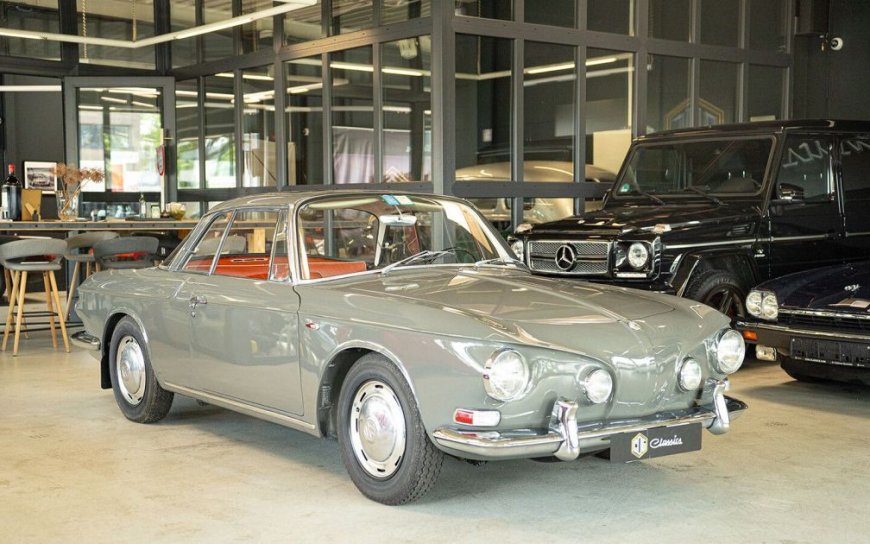A Work of Art: 1964 Volkswagen Karmann Ghia Type 34
Is the Volkswagen Type 34 Karmann Ghia truly a work of art? The seller of this 1964 1500 Karmann Ghia Coupe that we found in the Hemmings Classifieds evidently thinks so. Restored sometime after 2009 in its original color combination, this rare Karmann Ghia has been in a private collection on Italy’s Lake Como, where,… The post A Work of Art: 1964 Volkswagen Karmann Ghia Type 34 appeared first on The Online Automotive Marketplace.

Is the Volkswagen Type 34 Karmann Ghia truly a work of art? The seller of this 1964 1500 Karmann Ghia Coupe that we found in the Hemmings Classifieds evidently thinks so. Restored sometime after 2009 in its original color combination, this rare Karmann Ghia has been in a private collection on Italy’s Lake Como, where, according to the German classic-car dealer offering it for sale, it was displayed in the owner’s living room.
You’re probably familiar with Volkswagen’s Type 3 Squareback station wagon and Fastback coupe. You may even have seen an example of the Notchback sedan. But the Karmann Ghia built on the Type 3 chassis may be another story.

The Type 34 Karmann Ghia shares only its name with the curvaceous, Beetle-based coupes that began arriving on our shores in 1956. It was based on the Type 3 introduced in 1961, a larger, more conventional sedan powered by a larger, 1,500-cc version of VW’s air-cooled flat-four. Like the first Karmann Ghia, the Type 3 Karmann Ghia was meant to be a low-production, luxurious coupe version of the standard production sedan. Its distinctive, razor-edge styling by Ghia’s Sergio Sartorelli with an assist from American Tom Tjaarda was somewhat polarizing, but the car was a success from the start. There’s more than a hint of Corvair in the character line that circles the body at door-handle height, and it’s easy to see traces of the 1961 Plymouth in the car’s front-end “whiskers.” It was generally referred to as the “razor-edge Ghia,” or, in America, the “European Ghia” – probably because it wasn’t sold here.

The Type 34 shared the engine, transmission, drum brakes, and torsion-bar suspension of other Type 3s. Rather than the upright fan shroud used by the Type 1, the Type 3’s flat-four engine had its cooling fan mounted in line with the crankshaft, enabling the package to be much more compact.
Measuring just 18 inches tall, the engine left enough room for a shallow luggage compartment above, making the Type 34 a clever two-trunk design. In its original single-carbureted form, the 1500 was rated at 53 hp at 4,000 rpm.


As VW’s flagship, the Type 34 was well equipped. Standard features included fog lights, a cigarette lighter, a vanity mirror, an electric clock, a locking steering column, front and rear vent windows, variable wiper controls, and higher-quality upholstery. The power sunroof of this example was an optional extra. Largely hand-built, the Karmann Ghia was expensive, at about twice the cost of a standard 1500 sedan. Production amounted to 42,498 between 1961 and 1969, a fraction of the Type 1 Ghia’s run.

VW’s decision not to export the Type 34 to the United States didn’t stop Americans from trying to get their hands on them. Military servicemen and American tourists in Europe bought Type 34s and shipped them home, and U.S. VW dealers acquired cars through their European counterparts. Individual buyers have brought in more over the years — the enthusiast website thesamba.com estimates that about 45 percent of the surviving Type 34s are in Germany, with the U.S. accounting for 30 percent, and the U.K. 10 percent.
If you want to add this attention-grabbing Volkswagen to your collection, you’ll have to do as others have done, and arrange transport from Europe. Do you think this car’s rarity, styling, history, and condition make it worth the effort?
The post A Work of Art: 1964 Volkswagen Karmann Ghia Type 34 appeared first on The Online Automotive Marketplace.











































